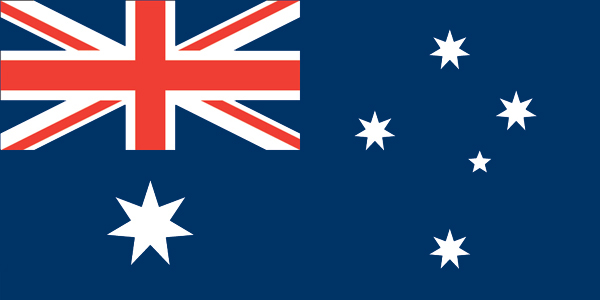
Australian National Flag
The National Flag of Australia contains three elements:
- The British Union Jack on a blue field - reflecting the historical origins of the Australian flag,
- The Southern Cross - reflecting Australia's geographic position in the Southern Hemisphere, and
- A seven pointed star - representing the Federation of six states, with an additional point to represent the territories collectively.
In addition to the Australian National Flag,
there are several other flags used by the Australian Defence Forces and
Commonwealth Government agencies. The Australian Army does not have a
separate flag, but uses the Australian National Flag. The Australian
Aboriginal flag and the Torres Strait Islanders flag in 1995 were
proclaimed to be Flags of Australia under the Flags Act 1953. Special flags are also used by HM the Queen when in Australia and by the Governor General.
Other Flags of Australia
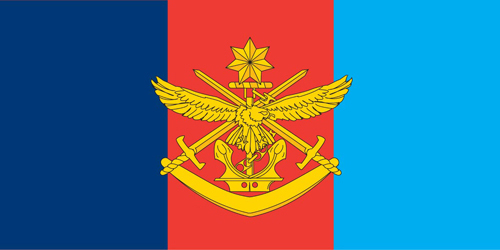 |
The Australian Defence Force Ensign - the flag represents the Australian Defence Force and the three services collectively. The dark blue stripe and the anchor in the central emblem represent the RAN, the red stripe and the crossed swords for the Australian Army, whilst the light blue stripe and eagle is for the RAAF. | |
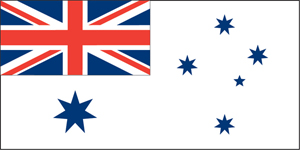 |
The Australian White Ensign - the national flag for use by commissioned warships and shore establishments of the Royal Australian Navy. The flag is flown by warships from the ensign staff at the stern. The blue Australian national flag is flown on the jack-staff at the bow, when vessels are in port. Prior to 1967, the RAN used the British White Ensign. | |
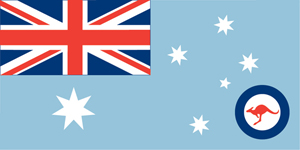 |
The RAAF Ensign - the official flag of the Royal Australian Air Force. The flag is flown at RAAF bases. Originally adopted in 1949, the ensign was modified in 1982 when the roundel was altered to include a red kangaroo. During World War II, the RAAF used the flag of the British Royal Air Force. | |
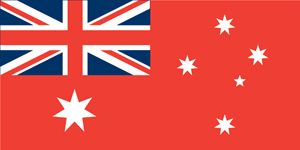 |
The Australian Red Ensign - the national flag for use by ships registered in Australia. From 1981 yachts and small ships may use the blue Australian National Flag in place of the Australian Red Ensign. | |
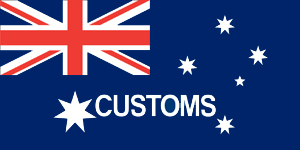 |
The Customs flag - the flag used by vessels in the service of the Australian Customs Service. The flag is also painted on the fuselage of aircraft undertaking Customs duties. | |
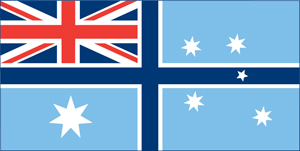 |
The Australian Civil Aviation flag - originally used by aircraft (flown from the pilot's window after landing) and flown at all Australian airports and other properties controlled by the Department of Civil Aviation, the flag is now only used by the Civil Aviation Safety Authority. | |
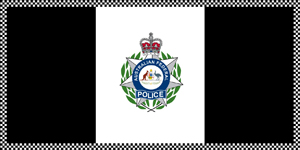 |
The Australian Federal Police flag - used on buildings and facilities operated by the Australian Federal Police. The flag was adopted in 1981. The checked border is part of the design, not a fringe. | |
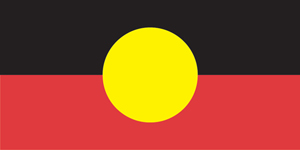 |
Australian Aboriginal Flag - A flag to represent and identify Australian Aboriginal people did not exist until 12 July 1971 when a flag designed by Mr Harold Thomas was first flown in Adelaide. The red stripe represents the land and the black symbolises the Aboriginal people. The yellow circle represents the Sun, the giver of life. Copyright of the Aboriginal Flag is owned by Mr Thomas who has granted an exclusive manufacturing licence to Carroll and Richardson Flagworld Pty Ltd. Originally designed in the proportions 3x5 the flag is now only available in the proportions of 1x2. | |
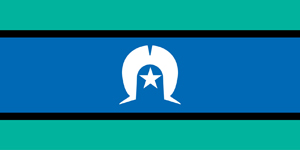 |
Torres Strait Islander Flag - A flag was adopted in May 1992 to represent the Torres Strait Islanders. The design is attributed to Mr Bernard Namok and copyright is owned by the Torres Strait Island Coordinating Council. The green stripes represent the land, the blue stripe represents the sea and the black symbolises the people. The central device is a Dhari, a dancer's headress with a 5-pointed star star to symbolise the five island groups in Torres Strait. | |
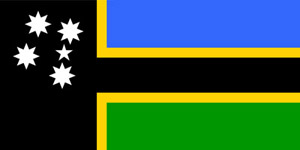 |
Australian South Sea Islanders Flag - South Sea Islanders are descendants of islanders brought from various Pacific islands from 1863 to 1904 to work as labourers in the Queensland sugar and timber industries. The flag was formally adopted in 1998 by the Australian South Sea Islanders United Council to represent this distinct community. The black panels symbolise the people standing strong and the continuity of their traditions, blue represents the sea and the sky and gold the sun, the green is for the land and the Islanders' contribution to agriculture. For more information visit www.flagsaustralia.com.au/ASSI.html | |
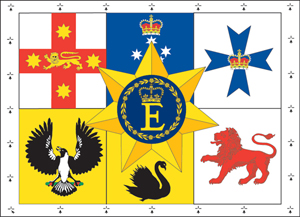 |
Her Majesty the Queen's Personal Flag for Australia - Since the 1963 Royal Visit of Australia, HM Queen Elizabeth II has used in Australia a distinctive personal flag, rather than the Royal Standard used when she is in the United Kingdom. The flag is a banner of the Australian Coat of Arms with a badge consisting of the Commonwealth Star upon which is the Queen's Royal badge showing her initial surmounted by a crown and surrounded by a garland of roses and wattle. Note that the Western Australian swan faces away from the hoist, the same as in the Coat of Arms. The correct proportions are 22 x 31, not the 1 x 2 proportions that are used for other British Royal Standards. | |
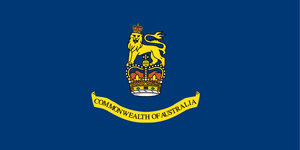 |
Governor-General's flag - The Queen's representative in Australia is the Governor-General whose flag is flown on buildings and other locations when he is present. A small version is used as a car pennant. The central device is the Royal Crest - a St Edward's Crown surmounted by a crowned lion. The Australian Governor-General's flag was introduced in 1936, a British Union Jack with a central badge featuring the Commonwealth Star and a Royal Crown having been previously used. | |
 |
United Nations flag - 24 October is United Nations Day and its flag is flown on that day in Australia. If there is only one flagpole, it may replace the Australian flag for the day. The United Nations was founded on 24 October 1945 with Australia one of the 51 original signatories. There are currently 193 member states. Australia has been an active member of the United Nations and its various agencies and it has contributed military and police forces to a number of peace-keeping missions. Australia was one of the 16 UN member countries that participated in the 1950-53 Korean Conflict in support of South Korea. |
Flags of Australia
ReplyDelete